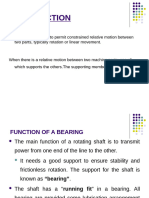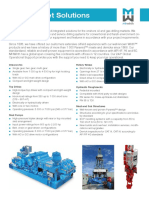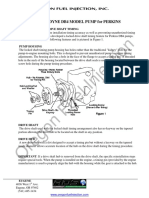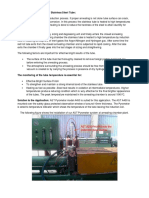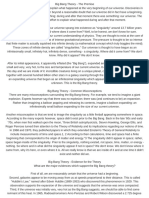AGN 076 - Alternator Bearings: Application Guidance Notes: Technical Information From Cummins Generator Technologies
AGN 076 - Alternator Bearings: Application Guidance Notes: Technical Information From Cummins Generator Technologies
Uploaded by
P.p. Arul IlancheeranCopyright:
Available Formats
AGN 076 - Alternator Bearings: Application Guidance Notes: Technical Information From Cummins Generator Technologies
AGN 076 - Alternator Bearings: Application Guidance Notes: Technical Information From Cummins Generator Technologies
Uploaded by
P.p. Arul IlancheeranOriginal Description:
Original Title
Copyright
Available Formats
Share this document
Did you find this document useful?
Is this content inappropriate?
Copyright:
Available Formats
AGN 076 - Alternator Bearings: Application Guidance Notes: Technical Information From Cummins Generator Technologies
AGN 076 - Alternator Bearings: Application Guidance Notes: Technical Information From Cummins Generator Technologies
Uploaded by
P.p. Arul IlancheeranCopyright:
Available Formats
Application Guidance Notes: Technical Information from Cummins Generator Technologies
AGN 076 – Alternator Bearings
BEARING TYPES
In the design of STAMFORD and AvK alternators, the expected types of rotor motion are
considered when deciding on the bearings to be fitted. Rotor motions considered are as
follows:
Axial rotation e.g. shaft rotation
Linear motion e.g. drawer
Spherical rotation e.g. ball and socket
STAMFORD and AvK alternators employ anti-friction and sleeve bearings. It is accepted that
these bearings create friction and heat losses, although the different types of bearing vary.
Anti-friction bearings
The advantages of anti-friction bearings are:
Standardized and normally easily available, worldwide.
Comparably cheap for smaller to medium alternators (does not apply to special
applications and special bearings).
Alternators are comparably compact/short, because of integrated bearing cartridges/
housings.
Comparably low friction losses.
Heat loss in the bearings is in most cases, lower than with sleeve bearings.
The starting friction for ball and roller bearings is rather low.
AGN 076 ISSUE B/1/8
The disadvantages of anti-friction bearings are:
Susceptible to brinelling during extended stationary periods.
Exact expected lifetime not easy to state.
Sensitive during storage and transportation.
Noisier than sleeve bearings.
Sleeve bearings
The advantages of sleeve bearings are:
Theoretically, unlimited lifetime when in permanent operation and provided that all
design parameters are met.
Low maintenance costs. Oil exchange intervals about 8000 hours in case of self
lubricated, self cooled sleeve bearings.
Exchange of bearing shells is possible without major dismantling of the alternator, or
disconnection from driver.
Not sensitive towards vibration and shocks during standstill and transit.
Low noise.
Bearing monitoring by temperature measurement gives a safe input for safe and early
shut down.
The disadvantages of sleeve bearings are:
At 1500 and 1800 rpm, an external oil cooling system is required to extract heat away
from the bearings.
The breakaway torque of a sleeve bearing supported rotor is significantly higher
compared to ball or roller bearings.
In case of excessive start and stops the expected lifetime of sleeve bearing shells is
significantly reduced if a jacking oil pump is not used.
STAMFORD Alternators
All STAMFORD single bearing and two bearing alternators are fitted with anti-friction deep
groove ball bearings. Sealed bearings are used on smaller alternators and regreaseable
bearings are used on the larger alternators in the range.
The primary reason for the selection of ball bearings, as opposed to roller or spherical roller
bearings are:
The degree of misalignment that can be tolerated in single bearing configurations.
The minimum loading required for satisfactory operation the bearing.
The re grease interval time for regreaseable bearings.
The resistance to brinelling.
AGN 076 ISSUE B/2/8
More detailed consideration was backed up with testing the options for ball bearings, as
opposed to roller or spherical roller bearings on the HC5E alternator. One of the most stressful
applications for an alternator’s bearings is Rail, where the alternator is subjected to excessive
UMP (unbalanced magnetic pull), vibration and shock loading. In deciding the optimum design
specific to alternators intended for Rail applications, the actual radial loading was taken into
consideration, where the effect of UMP of up to 4999 Newtons is expected.
During assembly with the rotor resting in the stator bore, the misalignment angle of the rotor in
relation to the stator centre line is 10 minutes (0.167 degrees). Considering bearing
capabilities, which are as follows:
Bearing Type Minimum Loading Allowed Misalignment
Ball 196 Newtons 10 minutes
Spherical roller 4140 Newtons 1.5 degrees
Cylindrical roller 1392 Newtons 3 minutes
Based on the minimum loading the Spherical roller bearing requirement is very close to the
actual radial load and is likely to skid in the races rather than turn. Bearing in mind the HC5
core length options for this frame size, this would be a risky selection. Allowed misalignment
is of course no problem and the bearing would provide some axial loading capability and
location.
The cylindrical roller bearing has a minimum loading well below the actual, but in this case the
allowed misalignment angle is too small to ensure that the bearing is not stressed and
damaged during the assembly process. It might be expected that with well-machined
components alignment, once assembled, would be within the limits of misalignment. There is
of course no axial load capability or axial restraint, which will place any axial loading stress on
to the discs and engine bearings.
The ball bearing on the other hand has a minimum loading well below the actual loadings and
an allowed misalignment angle that should ensure no damage is inflicted on the bearing during
assembly. There is also an axial load capability and location.
Both spherical roller and cylindrical roller bearings have a somewhat reduced regrease time
period, as it is more difficult to retain grease in the bearing.
Since movement of the rolling elements of these bearing types is restricted within the races,
compared to a ball bearing, there is a greater potential for damaging these types by brinelling.
Given these considerations, ball bearings are selected as the most suitable. There appears to
be no valid argument for fitting either a spherical roller or cylindrical roller bearings.
AGN009 details the expected life of a bearing. On a general note, it is possible that in a given
set of circumstances, were the ball bearing to be replaced with a spherical or cylindrical roller
bearing, that a similar bearing life could be expected, but the bearings might well be failing for
different reasons. For example; where a ball bearing might fail because of axial vibration,
AGN 076 ISSUE B/3/8
causing a fretting action in the housing, the cylindrical roller bearing might fail because of lack
of grease or misalignment damage.
The anti-friction ball bearings used on STAMFORD alternators are not insulated bearings. The
design of STAMFORD alternators is such that the shaft does not come under the influence of
magnetic fields that result in excessive voltage being generated along the axial length of the
shaft – know generally as circulating shaft bearing currents. For further information on shaft
bearing currents, refer to AGN033.
Single Bearing Alternator Shaft End Float
The Non-Drive End (NDE) bearing assembly on a STAMFORD single bearing alternator is
designed to allow the bearing to ‘float’ axially to ensure that under various less-than-ideal
conditions, described below, the bearing never exerts, or is subjected too, an axially force.
Common practice is to design the NDE bearing assembly such that the bearing internal
diameter is a tight fit when pressed onto the alternator shaft. But the bearing outer diameter
fits into an end bracket bearing assembly with a level of fit to allow the bearing to axially float
to a natural position of ‘ideal’ alignment.
Typically, the NDE bearing assembly will allow the bearing to float some +/- 2.0mm. This allows
the bearing to ‘self-align’ during the assembly of the alternator to the engine, when the
manufacturing tolerances of the alternator components such as frame, end bracket, adaptor,
shaft length, coupling hub, etc., combined with the engine flywheel, flywheel housing, etc.,
which will change the axially length of the alternator and so the real position of the NDE bearing
in its housing.
When the Generating Set is operating at working temperature, then differential thermal
expansion of the engine and alternator components will again change the ideal axial running
position of the NDE bearing in its housing.
By deciding to manufacture alternators with the NDE bearing having an unrestricted axial float
of some +/- 2.0mm around the ideal designed position for the NDE bearing; ensures that under
agreed component machining tolerances, plus differential thermal expansion, the bearing will
not become mechanically constrained. If it did become constrained, it would exert an axial
force onto the engine-alternator coupling, which in turn would exert an unwanted axial force
onto the engine crankshaft bearing thrust faces.
AvK Alternators
AvK single bearing and two bearing alternators are fitted with either anti-friction bearings or
sleeve bearings.
Anti-Friction Bearings
The anti-friction bearings used are all insulated, regreaseable bearings and may be ball or
roller and ball bearings.
AGN 076 ISSUE B/4/8
Roller bearings are fitted to the Drive End (DE) of the rotor.
Ball or ball and roller bearings are fitted to the Non-Drive End (NDE) of the rotor.
The bearing fitted to the DE on a two bearing alternator is fixed into a bearing cartridge.
The bearing fitted to the NDE on a two bearing alternator is fixed into a bearing
cartridge.
The bearing fitted to the NDE on a single bearing alternator is floating in a bearing
cartridge, with an unrestricted axial float of some +/- 2.0mm around the ideal designed
position for the NDE bearing.
Insulated anti-friction bearings are the standard fit on AvK DSG frames: 62, 74, 86, 99 and 114
(not 125). Anti-friction bearings are available on AvK DIG frames: 110, 120, 130, 142 and 150
(not 140 or 156).
Roller bearings at the DE.
Ball or ball and roller at the NDE.
Fixed NDE on 2-Brg. machines.
Floating NDE on 1-Brg. machines.
Sleeve Bearings
Insulated Sleeve Bearings are available on the AvK DSG frames: 74, 86, 99 and 114. They
are the standard fit on AvK DSG frame 125, but they are not available on the AvK DSG frame
62.
Insulated Sleeve Bearings are available on all AvK DIG frames and are standard fit on the AvK
DIG frames: 140 and 156. Different options of lubricant cooling methods are available for
sleeve bearings.
The alternator’s rotor will turn on a bed of oil. The oil system can be a dedicated oil reservoir
feeding the sleeve bearing in a separate and isolated system or the oil can be a shared supply
with engine. The following illustration shows a typical Sleeve Bearing lubrication system,
including the oil pump, reservoir, cooling unit and the mini water cooler:
AGN 076 ISSUE B/5/8
During continual operation, theoretically, the sleeve bearing will offer unlimited lifetime. That is
provided that all parameters are safe and stable. Frequent starting and stopping of an
alternator fitted with sleeve bearings and any significant variability in operational parameters,
can cause serious issues to the sleeve bearing outer races. Anti-friction bearing should be
selected for alternators that are intended for this type of application. However; in case of
untypical high number of starts and stops, hydrostatic jacking equipment is highly
recommended.
Hydrostatic jacking needs external oil flow and a considerable pressure in order to create a
sufficient oil film which can carry the bearing load. Hydrostatic jacking is effectively used to
minimize:
Start-up torque.
Bearing wear at start-stop sequences.
Prevent the bearing from weak oil wedges at low speeds (cold turning in case of turbine
application, maintenance on piston engines).
BEARING SELECTION FOR GENERATING SETS
All STAMFORD alternators are available with single bearing or two bearing rotors, with the
exception of the UCD alternators, which are single bearing only and the largest P80 alternators
AGN 076 ISSUE B/6/8
(W, X and Y cores), which are two bearing only. AvK alternators may be designed to specific
customer requirements.
The UCD alternators have a special cooling fan and voluted end bracket to give the alternators
improved cooling and a slightly higher output rating.
Single Bearing Alternator or Two Bearing Alternator?
This is regard as a decision that must be based on GOEM engineering considerations into
their unique Generating Set design intended for their product package functionality, which
explores the following considerations:
Cost effective engineering for the power generation package.
Application specific constructional needs.
Site location and associated transport- handling risks.
Proposed and contractually acceptable mobility of the in-service package.
Size-weight-shape issues of package.
If the GOEM has undertaken the necessary technical assessment and so produced an
appropriate design where all critical aspects have been duly considered, then this should
ensure the areas of risk are mitigated. There should then be no commercial or technical
concerns regarding the type of alternator and therefore; no preference regarding a single
bearing or two bearing Generating Set construction. Historically, the use of single bearing
alternators was driven by the Generating Set industry. In more recent years, the drive for high
power to weight engines (high BMEP for given swept volume) has initiated a reverse to that
trend brought about by torsional analysis concerns. The net result; manufactured quantities of
two bearing alternators has increased.
The GOEM’s mechanical engineers must conduct the necessary torsional analysis and take
the following design considerations into account:
The suitability of the prime mover to support the alternator’s rotor mass.
Having a suitable flywheel housing design in terms of stiffness and rigidity with the
engine cylinder block.
Provide the necessary support for the total mass of the alternator.
The design and construction of a suitable Generating Set mechanical support scheme
in terms of Base-frame design and carefully considered AVM location.
If it is intend to build a 'close-coupled' two bearing Generating Set, then it requires the fitting of
an adapter onto the Drive End (DE) of the alternator in order to fit to the engine’s flywheel
housing. Then it will be necessary for the Generating Set manufacturer to buy and install a
coupling that will fit within this limited space. It must be a coupling type that fits together as a
sliding assembly because, with the adapter around the outside of the coupling, there will be
very limited access for any difficult coupling assembly procedure.
AGN 076 ISSUE B/7/8
If it’s intend to build an 'open-coupled' arrangement with no direct 'adapter' connecting together
the alternator frame DE bracket to the engine flywheel housing, then the Generating Set
manufacturer must design a very strong and carefully considered base frame, to support the
engine and alternator. This base frame must have no (absolutely minimal) angular twisting /
bending moment under full load torque, or load step changes, and also stiff enough in the axial
direction not to flex/bend lengthways and cause misalignment. This base frame will also need
to be Anti-Vibration Mounted (AVM) to a bedplate and when the Generating Set is installed,
care must be taken to 'set-up' and ‘level’ the assembly into a perfect and unstressed plane of
alignment.
Note. Engine adaptors and couplings are available with single bearing alternators. Engine
adaptors only are available with two bearing alternators.
Application Guidance Notes are for information purposes only. Cummins Generator Technologies reserves the right to change the contents of
Application Guidance Notes without notice and shall not be held responsible for any subsequent claims in relation to the content.
AGN 076 ISSUE B/8/8
You might also like
- Lean Burn or Rich Burn?: It Depends On What Meets The Customer's Application NeedsDocument4 pagesLean Burn or Rich Burn?: It Depends On What Meets The Customer's Application Needsciprian_dalvaruNo ratings yet
- QSK60-M-2700hk - 1900rpmDocument2 pagesQSK60-M-2700hk - 1900rpmjose67% (3)
- 4bta3 9 G4 PDFDocument3 pages4bta3 9 G4 PDFConfioEnJesucristoNo ratings yet
- Ficha Técnica Engine Gas L7042GSI PDFDocument2 pagesFicha Técnica Engine Gas L7042GSI PDFCamilo Sanchez VanegasNo ratings yet
- Alcad CellDocument32 pagesAlcad CellIsaac VoonNo ratings yet
- Module 9 - T.shootDocument26 pagesModule 9 - T.shootWilliam RuizNo ratings yet
- Module 8 - ToolsDocument17 pagesModule 8 - ToolsWilliam RuizNo ratings yet
- Ti 1000 0206 - enDocument2 pagesTi 1000 0206 - enJamil AhmedNo ratings yet
- Module 4 - Oper PDFDocument13 pagesModule 4 - Oper PDFWilliam RuizNo ratings yet
- Superior Engines Product OverviewDocument45 pagesSuperior Engines Product Overviewwellington freitasNo ratings yet
- Jenbacher: 1. General ConditionsDocument4 pagesJenbacher: 1. General ConditionsArîfNo ratings yet
- Public 1560308493 85265-Marineengine-Sm-2019Document90 pagesPublic 1560308493 85265-Marineengine-Sm-2019Dwiko RiyonoNo ratings yet
- Module 4s - Routine MaintenanceDocument53 pagesModule 4s - Routine MaintenanceWilliam Ruiz100% (1)
- Gas Turbine ResearchDocument13 pagesGas Turbine ResearchKrishna MyakalaNo ratings yet
- Fuel RecommendationsDocument7 pagesFuel RecommendationsLaiqNo ratings yet
- Reliable, Durable and Easy To Handle The Jenbacher P611 Spark PlugDocument2 pagesReliable, Durable and Easy To Handle The Jenbacher P611 Spark PlugMuhammad Tilal AshrafNo ratings yet
- 18V28-32H, Engine No 21828, Umaid Mills 2 - 617 - 620Document102 pages18V28-32H, Engine No 21828, Umaid Mills 2 - 617 - 620Jiyaul prime100% (1)
- QSV91G Containerized SpecificationDocument26 pagesQSV91G Containerized SpecificationmackyyoNo ratings yet
- Marine Gas TurbinesDocument6 pagesMarine Gas TurbinesAqeila Muz DalifahNo ratings yet
- SGT Torque Converter Governor: Supplement To Manual 04048Document24 pagesSGT Torque Converter Governor: Supplement To Manual 04048pcatruongNo ratings yet
- CENSE™ CM530 Obsoleted and Replaced by Next Generation CENSE™ CM2330Document9 pagesCENSE™ CM530 Obsoleted and Replaced by Next Generation CENSE™ CM2330edilbertoNo ratings yet
- Module 4 - EngineDocument38 pagesModule 4 - EngineWilliam RuizNo ratings yet
- 1000 KVa Generator CatalougeDocument6 pages1000 KVa Generator Catalougerakeshamech100% (2)
- Cummins Gen Details 2500KVADocument3 pagesCummins Gen Details 2500KVAshaiful islamNo ratings yet
- CAT Gas Engine Operation ModeDocument16 pagesCAT Gas Engine Operation Modeburcin GozalNo ratings yet
- 5410584Document14 pages5410584Massahiro Filho100% (1)
- 0416 VHP Afr2 UpgradeDocument1 page0416 VHP Afr2 Upgradenicol_sgNo ratings yet
- Renk EF 35-45 PDFDocument8 pagesRenk EF 35-45 PDFdanijelpartoviNo ratings yet
- Cat 3612leDocument4 pagesCat 3612letomjones77100% (1)
- Innio JB Factsheet Service Type 4e Screen en Ijb-222040-EnDocument1 pageInnio JB Factsheet Service Type 4e Screen en Ijb-222040-EnLukarsa2013No ratings yet
- B20 - Presentation 2Document34 pagesB20 - Presentation 2Ivan_UwaisNo ratings yet
- Tata Cummins - SM PrezDocument21 pagesTata Cummins - SM PrezAnsuman Nayak100% (1)
- 5b - Lube System2Document22 pages5b - Lube System2agvassNo ratings yet
- Innio j920 Powerpack Brochure enDocument5 pagesInnio j920 Powerpack Brochure enRogelio PerozoNo ratings yet
- Fs p611 Sparkplug Ijb-222027-EnDocument2 pagesFs p611 Sparkplug Ijb-222027-EnwaltsdavinNo ratings yet
- Heat Rejection and Temperature Limitations: Figure 1. LM2500 Maximum Allowable Casing TemperaturesDocument6 pagesHeat Rejection and Temperature Limitations: Figure 1. LM2500 Maximum Allowable Casing TemperaturesDenis Jimenez100% (1)
- Student's MdedhDocument86 pagesStudent's MdedhthomasdilirionNo ratings yet
- VHP5904LTD: Basic SpecificationsDocument2 pagesVHP5904LTD: Basic SpecificationsferyNo ratings yet
- Maintenace Manual For SPICDocument180 pagesMaintenace Manual For SPICaditigupta100k100% (1)
- FNDSC - MS9001Document59 pagesFNDSC - MS9001shravani mangalpalliNo ratings yet
- Seminar Report Final AzharDocument37 pagesSeminar Report Final AzharManjeet SinghNo ratings yet
- Jenbacher: Operational Data To Be Read Unit Mo. Tu. We. Th. Fr. Sa. SuDocument1 pageJenbacher: Operational Data To Be Read Unit Mo. Tu. We. Th. Fr. Sa. SuArîfNo ratings yet
- Jenbacher: 1. Range of ApplicationDocument1 pageJenbacher: 1. Range of ApplicationArîfNo ratings yet
- Module 8 - MaintDocument19 pagesModule 8 - MaintWilliam RuizNo ratings yet
- Cummins Marine Products Guide 2023Document140 pagesCummins Marine Products Guide 2023Application Engineer Jakson MarineNo ratings yet
- Disassembly:: W 0704 M0 Gas-MixerDocument4 pagesDisassembly:: W 0704 M0 Gas-MixerHelder PintoNo ratings yet
- Marine Gas Turbine: Performance LM6000PC LM6000PG OutputDocument2 pagesMarine Gas Turbine: Performance LM6000PC LM6000PG Outputgasturbina4983No ratings yet
- Gujarat Technological University: L.D. College of Engineering, AhmedabadDocument19 pagesGujarat Technological University: L.D. College of Engineering, AhmedabadRaumil ManiarNo ratings yet
- Specifications: General InformationDocument15 pagesSpecifications: General InformationyemenNo ratings yet
- Railway Engine Training-CUMMINS EngineDocument50 pagesRailway Engine Training-CUMMINS Enginemajjisat100% (1)
- Arrow Product OverviewDocument13 pagesArrow Product OverviewRafael Zurita100% (1)
- Genuine Cummins Celect PX Injectors: Better Reliability. Every TimeDocument2 pagesGenuine Cummins Celect PX Injectors: Better Reliability. Every TimeMassahiro Filho100% (1)
- 334.00-11 The Turning Gear PDFDocument3 pages334.00-11 The Turning Gear PDFOleg Shkolnik100% (2)
- Gaseous Fuel Systems - Application & Installation GuideDocument36 pagesGaseous Fuel Systems - Application & Installation GuidelamNo ratings yet
- Nateria Brochure PDFDocument6 pagesNateria Brochure PDFJavier Alejandro Muralles ReyesNo ratings yet
- Chapter 4 Rev 1-1Document72 pagesChapter 4 Rev 1-1ahmadmosadeghNo ratings yet
- Turbo Generator PDFDocument5 pagesTurbo Generator PDFAlfeusShalonda100% (1)
- Motor Bearings - ABBDocument8 pagesMotor Bearings - ABBhozipek5599100% (1)
- Bearings Types of Damages and Their Causes: Kushal Dhungana Ab13 Professor: José Brigas and Pedro Alves IndiceDocument12 pagesBearings Types of Damages and Their Causes: Kushal Dhungana Ab13 Professor: José Brigas and Pedro Alves Indiceuploadz upNo ratings yet
- Rolling Contact BearingDocument45 pagesRolling Contact Bearingabhangchetan01No ratings yet
- Journal BearingDocument7 pagesJournal BearingNur AfifahNo ratings yet
- 128 - GS Level Industrial Level Sensor - LD4174-M Issue 2Document2 pages128 - GS Level Industrial Level Sensor - LD4174-M Issue 2P.p. Arul IlancheeranNo ratings yet
- Polycab Cables Pricelist (New)Document8 pagesPolycab Cables Pricelist (New)P.p. Arul IlancheeranNo ratings yet
- Land Market Solutions: Drawworks Rotary TablesDocument2 pagesLand Market Solutions: Drawworks Rotary TablesP.p. Arul IlancheeranNo ratings yet
- Coolant Filter, Spin-On Sca Plus: AttributesDocument2 pagesCoolant Filter, Spin-On Sca Plus: AttributesP.p. Arul IlancheeranNo ratings yet
- GSM Security System Ac230v New PDFDocument3 pagesGSM Security System Ac230v New PDFP.p. Arul IlancheeranNo ratings yet
- Ojus Ol 5d Portable Genset PDFDocument2 pagesOjus Ol 5d Portable Genset PDFP.p. Arul IlancheeranNo ratings yet
- 0 5PX1CBLKFLX100Document4 pages0 5PX1CBLKFLX100P.p. Arul IlancheeranNo ratings yet
- 2 X1.3TAA G7 - 20kVA - Rev 2Document4 pages2 X1.3TAA G7 - 20kVA - Rev 2P.p. Arul IlancheeranNo ratings yet
- Stanadyne Lock Timing PerkinsDocument1 pageStanadyne Lock Timing PerkinsP.p. Arul IlancheeranNo ratings yet
- 2-Basic - Feb 12 ONGC - Cleaned PDFDocument36 pages2-Basic - Feb 12 ONGC - Cleaned PDFP.p. Arul Ilancheeran100% (1)
- Vashi Electricals BrochureDocument26 pagesVashi Electricals BrochureP.p. Arul Ilancheeran100% (1)
- CTS2 5unDocument3 pagesCTS2 5unP.p. Arul IlancheeranNo ratings yet
- GSM 6 Relay Switch 2019Document2 pagesGSM 6 Relay Switch 2019P.p. Arul IlancheeranNo ratings yet
- Smart APUDocument2 pagesSmart APUP.p. Arul IlancheeranNo ratings yet
- TMT3978-TB Installation Instructions PDFDocument3 pagesTMT3978-TB Installation Instructions PDFP.p. Arul IlancheeranNo ratings yet
- Tmt7839 Wiring DiagramDocument1 pageTmt7839 Wiring DiagramP.p. Arul IlancheeranNo ratings yet
- Ecp-4083935oampmecpg PDFDocument100 pagesEcp-4083935oampmecpg PDFP.p. Arul Ilancheeran100% (1)
- Cummins Alternator PDFDocument41 pagesCummins Alternator PDFP.p. Arul IlancheeranNo ratings yet
- Sci-9-Q4-Module-7-Week 7Document17 pagesSci-9-Q4-Module-7-Week 7shimuraririkkuNo ratings yet
- Chapter 3 Solutions Modern Physics 4th EditionDocument24 pagesChapter 3 Solutions Modern Physics 4th EditionPaulo FontesNo ratings yet
- Philosophical Magazine Volume 21 Issue 172 1970 (Doi 10.1080/14786437008238472) Landauer, Rolf - Electrical Resistance of Disordered One-Dimensional LatticesDocument6 pagesPhilosophical Magazine Volume 21 Issue 172 1970 (Doi 10.1080/14786437008238472) Landauer, Rolf - Electrical Resistance of Disordered One-Dimensional LatticesAlejandro Herrera CarvajalNo ratings yet
- Isolation TransformerDocument6 pagesIsolation TransformerVaibhav AryaNo ratings yet
- Overview of RT-2 Exams - LaxmiDocument2 pagesOverview of RT-2 Exams - LaxmiVenkatesh VenkyNo ratings yet
- B737 Family Manual - CL Vs NGDocument20 pagesB737 Family Manual - CL Vs NGta_ac117100% (3)
- Stoichiometric Calculations: Review of Fundamental ConceptsDocument24 pagesStoichiometric Calculations: Review of Fundamental ConceptsHari Madhavan Krishna KumarNo ratings yet
- Corto CircuitoDocument30 pagesCorto CircuitoManuel RochaNo ratings yet
- Applied Physics For Ec - Ee Stream-2022 SchemeDocument2 pagesApplied Physics For Ec - Ee Stream-2022 Schemeazeemulla034No ratings yet
- 1546814Document104 pages1546814Miguel Antonio GarcíaNo ratings yet
- THE FULL PAPER by DR Sab Safi of SDT Drives PDFDocument10 pagesTHE FULL PAPER by DR Sab Safi of SDT Drives PDFmohanNo ratings yet
- Unit 3 Vocabulary Short Test 1 A+BDocument1 pageUnit 3 Vocabulary Short Test 1 A+Bydbzbccq6dNo ratings yet
- Efficient Distric Heating and Cooling SystemsDocument146 pagesEfficient Distric Heating and Cooling SystemsBoraNo ratings yet
- Dynamic Relaxation Analysis of The Non-Linear Static Response of Pretensioned Cable RoofsDocument9 pagesDynamic Relaxation Analysis of The Non-Linear Static Response of Pretensioned Cable RoofsJoaquin VieraNo ratings yet
- MKT 558 Pestel AnalysisDocument1 pageMKT 558 Pestel Analysisasta paiNo ratings yet
- Lithium Ion Secondary Batteries and Super CapacitorsDocument17 pagesLithium Ion Secondary Batteries and Super Capacitorsdhandapani dhanalakshmiNo ratings yet
- Agitated Thin-Film EvaporatorsDocument4 pagesAgitated Thin-Film Evaporatorsزهرة النرجس100% (4)
- Tutorial Centrifugal Pumps 2 Solution PDFDocument10 pagesTutorial Centrifugal Pumps 2 Solution PDFKEIDY DAYANA GARNICA MENANo ratings yet
- Nios Tma EnglishDocument2 pagesNios Tma EnglishSoham AhluwaliaNo ratings yet
- SRV - ConnectorDocument4 pagesSRV - Connectorkoroosh0kNo ratings yet
- Properties of Wet GasesDocument18 pagesProperties of Wet GasesAlejandro Perez100% (1)
- London Commodity News Monday 21st March 2011Document35 pagesLondon Commodity News Monday 21st March 2011nisritaNo ratings yet
- Masibus Tcs 4050m - Loop Calibrator - Cb-2 - tcs4050m - r2 - 0110Document2 pagesMasibus Tcs 4050m - Loop Calibrator - Cb-2 - tcs4050m - r2 - 0110kazishahNo ratings yet
- Oxford Exam Trainer b2 Audioscript HuDocument36 pagesOxford Exam Trainer b2 Audioscript HuAnna Szabóné Szanyi NagyNo ratings yet
- Bright Annealing Process of Stainless S Teel TubeDocument2 pagesBright Annealing Process of Stainless S Teel TubeAgniva DuttaNo ratings yet
- Big Bang Theory - The PremiseThe Big Bang theory is an effort to explain what happened at the very beginning of our universe. Discoveries in astronomy and physics have shown beyond a reasonable doubt that our universe (1).pdfDocument4 pagesBig Bang Theory - The PremiseThe Big Bang theory is an effort to explain what happened at the very beginning of our universe. Discoveries in astronomy and physics have shown beyond a reasonable doubt that our universe (1).pdfaceNo ratings yet
- Electra 329Document135 pagesElectra 329Clotilde RodinoNo ratings yet
- Heating, Ventilation and Air Conditioning (HVAC) Equipment: A Guide To Equipment Eligible For Enhanced Capital AllowancesDocument12 pagesHeating, Ventilation and Air Conditioning (HVAC) Equipment: A Guide To Equipment Eligible For Enhanced Capital AllowancesdozajNo ratings yet
- About Electrical Grounding: The Concept of Sphere of Influence When Determining Grounding Electrode EfficiencyDocument2 pagesAbout Electrical Grounding: The Concept of Sphere of Influence When Determining Grounding Electrode Efficiencyraja kumarNo ratings yet



























































